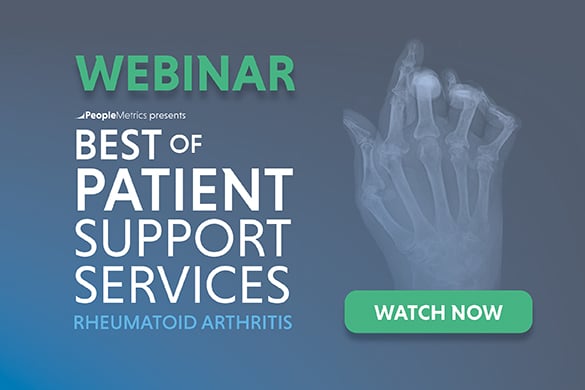Last week, PeopleMetrics attended CBI’s 14th Hub and SPP Model Optimization conference at the Loews Hotel in Center City Philadelphia.
At this conference, experts from Hubs, specialty pharmacies, and manufacturers gathered to discuss their experiences in building patient support programs, both good and bad.
Getting your support services right is important, as they drive successful onboarding, adherence and connection to your medication.
According to Derek Cothran, Senior Consultant at Protean,
Patient support programs are as critical as the price and efficacy to a product’s success.
So when you’re a pharmaceutical company, what do you need to consider when designing your own patient support services program to make sure you’re getting it right?
Speakers at the event highlighted these three considerations:
1. Insourced, outsourced, or both?
Pharmaceutical companies are the experts in their therapeutic area and medicine, but that doesn’t mean they’re adept at providing support services for those medicines.
Deciding if you want to insource or outsource your patient support services team has pros and cons:
- Insourced teams allow for full control. You choose exactly what services you want to provide, internal teams make it easier to build internal expertise for complex disease states, and you directly control the patient experience.
However, that control comes at a cost. You have to build your own call center operations and scaling that as patients onboard can be challenging. - Outsourced teams trade control for scaling and operational expertise. Hubs are experts in providing call center operations, platforms for managing patient access, and scaling.
However, you need to manage the patient experience through partner Hubs.
And just because patient support services is outsourced to a Hub does not mean Pharma companies are outsourcing the patient experience. They still own this and it must be managed.
Keep in mind that you don’t have to pick one or the other.
97f6.jpg)
DeWayne Manning, Partner at Archbow Consulting noted,
More often now are hybrid insource/outsource models where insourced items are the critical customer touchpoints and the outsourced pieces are the backend operations and appeals.
This hybrid model looks to strike a balance between controlling the patient experience while still getting the benefits of scale.
The right model for you will be heavily dependent on the services you offer, which leads to the next consideration.
2. Not All Offerings are the Same — Build A Patient Support Services Program Based on Your Patients' Needs
Patient support services generally offer a similar set of offerings that assist patients and HCPs with financial and physical access to therapy.
However, financial and physical access needs for your product will vary widely depending on several factors: therapeutic area, makeup of your patient population, type of insurance coverage, and connections to specialty pharmacies (to name a few).
2f98.jpg)
Jeff Doherty, Access Solutions Director at Janssen, noted how his team has had to change their medical benefits offering:
When it started, it was just mail-in rebates. Now it’s rebates, debit cards, check, and more. How do we best work with the providers workflow and the patient to get the best outcomes?
As Jeff notes, the most important question to ask yourself is what do you need to do to drive outcomes?
Identify what your specific patient needs will be and build a patient support program catered to that.
9958.jpg)
Alan Balch, CEO of the Patient Advocate Foundation, describes this as “precision navigation"
Sort of like precision medicine, we think of it as 'precision navigation' — getting patients to the right help at the right time.
And this extends beyond the services offered. It’s also how you communicate these services.
Liam Moy, Director of Patient Services at Sage Therapeutics, noted how the communication channel makes a big difference.
We spend a lot of time communicating with patients. Most patients don’t want to talk on the phone and they certainly don’t want to talk on the phone to a number they’ve never seen before, so we’ve started a little bit of texting and it’s making a huge difference. You have to meet them where they are.
But how do you build the right services and the right channels? That’s the final consideration.
3. Build and Manage Your Patient Support Program with the Patient Voice
To best serve your patients' needs, you need to hear directly from them.
This is because your internal understanding of patient needs may differ from their daily experience, and best way to understand their needs is to ask and listen.
This is true regardless of the patient support services you offer, or whether they’re insourced or outsourced.
In fact, patient feedback is especially important for outsourced teams, as your hub partner is a representative of your company, and you need to measure how patients feel about these interactions.
As Meghan Szczech, Senior Director of Patient Services at SK Life Sciences describes,
You need to know how you’re going to get the feedback on your program and how you’re going to implement it. One thing about patient support services is that there’s always room for improvement.
Without patient (and HCP) feedback, those improvements could be focused on items that are important internally, but not to the patient.
Focus your initial build and future improvements by hearing from those you need to serve, the patients.
In conclusion, building and maintaining patient support services require an evaluation of what services you’re providing and who is providing these services.
If you want to know if the services and service providers you’ve chosen are meeting your patient’s needs, there is only one way to do it, and it’s to ask patients for their feedback.
|
Learn how PeopleMetrics can help collect feedback & optimize your patient support program. Contact Us! |
About the Author
Kirk Lohbauer is a Senior Business Development Manager at PeopleMetrics. In his 6 years at PeopleMetrics, Kirk has worked extensively in all aspects of CEM program development from initial specifications, crafting a suggested program and surveys, survey launch, and subsequent action-taking and improvements. Outside of the office, Kirk can be found bicycling around Philadelphia, going to concerts, and trying his best to read a book at his coffee shop instead of reading Twitter (with varying degrees of success). Click here to get in touch.

.jpg)




